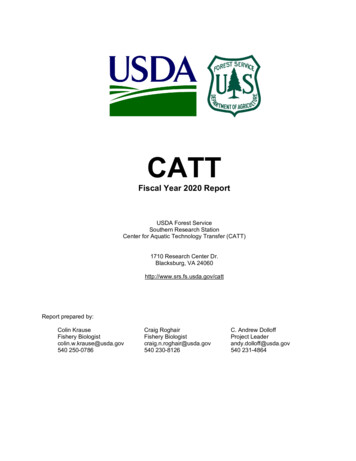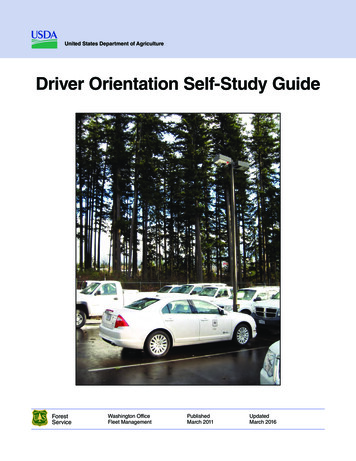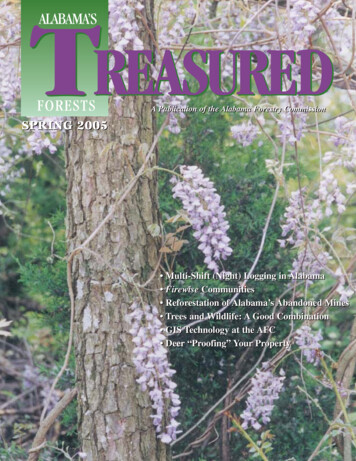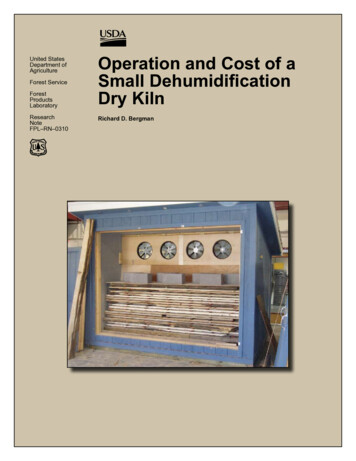
Transcription
CATTFiscal Year 2020 ReportUSDA Forest ServiceSouthern Research StationCenter for Aquatic Technology Transfer (CATT)1710 Research Center Dr.Blacksburg, VA 24060http://www.srs.fs.usda.gov/cattReport prepared by:Colin KrauseFishery Biologistcolin.w.krause@usda.gov540 250-0786Craig RoghairFishery Biologistcraig.n.roghair@usda.gov540 230-8126C. Andrew DolloffProject Leaderandy.dolloff@usda.gov540 231-4864
Fiscal Year 2020 Executive SummaryFiscal Year 2020 won’t soon be forgotten. We began the year by saying good-bye to a long-time colleagueand CATT advocate, Regional Fisheries Program Manager, Leigh McDougal. Leigh recognized early in hertenure the valuable link CATT provided between managers and researchers, and we experienced significantgrowth and diversification of our program under her leadership. Southern Region Aquatic Ecologist KevinLeftwich both continued his role with CATT and assumed Leigh’s duties early in FY20. At mid-year, wewelcomed Leigh’s replacement Amy Carson as she joined the BPR Team in Atlanta as the Regional FisheriesProgram Manager. We are excited by Amy’s selection and together we look forward to the many opportunitieswe will have to maximize the value of CATT in FY21 and beyond.Of course, by far the most significant event of 2020 was the pandemic. COVID-19 severely impacted our fieldoperations throughout the majority of FY20. Beginning in March, we paused all field work for several months.During the pause we kept our team members busy working on data QA/QC, updating field manuals, anddeveloping a new data collection tool. We also developed COVID safety plans in collaboration with ourinternal and external partners so we could hit the ground running when we returned to the field, whichhappened in July. We started small and cautiously, focusing on high priority, relatively local projects thatposed minimal risk to the health and safety of our crews and partners. Despite the COVID-related limitationsand delays we provided several partners (details in the following pages) with the information and tools theyneed to and increase the pace and scale of forest restoration, make informed management decisions, andconnect people to the outdoors.What is CATT?The Center for Aquatic Technology Transfer (CATT) is a science delivery program. CATT biologists andtechnicians are Southern Research Station (SRS) employees funded by the National Forest System (NFS)and other partners. Guided by core values of communication, partnership, inclusion, accountability, andsafety, we collaborate with the Forest Service science community and others to develop custom solutions forour project partners.When was CATT created, and why?The CATT was created in 1995 in response to the growing need for research technologies to be applieddirectly to management challenges. The number of research personnel was, and still is, too small relative tothe number of fisheries and aquatics resource managers to satisfy specific needs. Our mission is to increasethe capacity of our partners through delivery of science-based support.Where does CATT work?Full-time CATT personnel are stationed in Blacksburg, VA and provide services throughout the U.S.What services does CATT provide?Our focus is on aquatics related management challenges. Our flexible organizational structure allows us torapidly develop and apply custom solutions to both short and long term projects. Past projects range fromproviding a field technician for an afternoon of fish sampling, to region-wide, multi-year efforts, includingsampling design, personnel management, data analysis, and reporting.How can I learn more about CATT?Contact Craig Roghair 540 230-8126 (craig.n.roghair@usda.gov), or visit our website:http://www.srs.fs.usda.gov/catt.USDA Forest Service, Southern Research Station1710 Research Center Dr., Blacksburg, VA 24060Center for Aquatic Technology Transfer (CATT)540 230-8126; http://www.srs.fs.usda.gov/catt
CATT field teams were able to complete projects on two national forests (green) and a national park (orange)in fiscal year 2020. Projects on several national forests (yellow) were postponed due to COVID precautions.The USDA-FS, SRS CATT is headquartered in Blacksburg, VA (red circle).FY 2020 CATT field projects.PartnerProject TypeFrancis Marion & Sumter National ForestsGeorge Washington & Jefferson National ForestsGeorge Washington & Jefferson National ForestsRocky Mountain Research StationShenandoah National ParkSouthern Region (R8) Regional OfficeSouthern Research StationStream fish and habitat inventoryFreshwater snorkeling education programStream channel classificationEnvironmental DNA (eDNA) sampling in VirginiaBrook Trout population estimatesProvide base funding and support for the CATTMovement of wood in streamsFY 2020 projects postponed or cancelled due to COVID.PartnerDaniel Boone National ForestFrancis Marion & Sumter National ForestsFrancis Marion & Sumter National ForestsGeorge Washington & Jefferson National ForestsKisatchie National ForestNational Forests in AlabamaOzark–St. Francis National ForestShenandoah National ParkSouthern Research StationUSDA Forest Service, Southern Research Station1710 Research Center Dr., Blacksburg, VA 24060Project TypeMine impacts on stream healthStream fish and habitat inventoryFreshwater snorkeling education programFreshwater snorkeling education programForest-wide stream monitoringBlue Shiner monitoringStream fish and habitat inventoryBrook Trout population estimatesAmerican Eel growth and movementCenter for Aquatic Technology Transfer (CATT)540 230-8126; http://www.srs.fs.usda.gov/catt
Francis Marion & Sumter National ForestsFrancis Marion DistrictProject TypeStream fish and habitat inventoryGoalProvide stream biota and habitat information needed for project-level and Forest-level planningObjectiveComplete stream fish and habitat inventory in November 2019ApproachForest identifies streams with gaps in fish or habitat informationThe CATT trains and deploys field teams to complete inventoriesThe CATT provides project database for incorporation into forest datasetsAccomplishmentsCompleted 16 miles of habitat inventory on 22 streamsSampled fish in 6 streams at a total of 12 sitesEntered data into project database and provided to project partnerPartners and ContactsForest Contact: Keith Whalen, Forest Fisheries BiologistElectrofishing in Cane Gully BranchHabitat inventory of Island BranchProject SummaryPeriodic aquatic resource assessments provide the information national forest managers need toeffectively identify current status and trends, management options and impacts, and threats and impacts offire, insects, disease, and other natural processes on aquatic resources. In 2019, Francis Marion NationalForest partnered with the CATT to assess stream habitat and fish in high-priority management areas, thelatest effort in a long history of inventory and monitoring partnerships on the forest. Our current effort isintended to fill data gaps and update aquatic resource information needed for forest- and project-levelanalyses. We will return to the Sumter in 2021 to continue stream assessments in high priority watershedsidentified by the Francis Marion National Forest.USDA Forest Service, Southern Research Station1710 Research Center Dr., Blacksburg, VA 24060Center for Aquatic Technology Transfer (CATT)540 230-8126; http://www.srs.fs.usda.gov/catt
Francis Marion & Sumter National ForestsAndrew Pickens DistrictProject TypeStream fish and habitat inventoryGoalProvide stream biota and habitat information needed for project-level and Forest-level planningObjectiveComplete stream fish and habitat inventory in March 2020ApproachForest identifies streams with gaps in fish or habitat informationThe CATT trains and deploys field teams to complete inventoriesThe CATT provides project database for incorporation into Forest datasetsAccomplishmentsCompleted 10.7 miles of habitat inventory on 5 streamsSampled fish in 5 streams at a total of 22 sitesEntered data into project database and provided to project partnerPartners and ContactsForest Contact: Keith Whalen, Forest Fisheries BiologistWaterfall encountered on Crane CreekLarge wood is classified and recordedProject SummaryPeriodic aquatic resource assessments provide the information National Forest managers need toeffectively identify current status and trends, management options and impacts, and threats and impacts offire, insects, disease, and other natural processes on aquatic resources. In 2020, Sumter National Forestpartnered with the CATT to assess stream habitat and fish in high-priority management areas, the latesteffort in a long history of inventory and monitoring partnerships on the Forest. Our current effort is intendedto fill data gaps and update aquatic resource information needed for Forest- and project-level analyses.We will return to the Andrew Pickens as requested to continue stream assessments in high prioritywatersheds identified by the Francis Marion National Forest.USDA Forest Service, Southern Research Station1710 Research Center Dr., Blacksburg, VA 24060Center for Aquatic Technology Transfer (CATT)540 230-8126; http://www.srs.fs.usda.gov/catt
George Washington & Jefferson National ForestsLee Ranger DistrictProject TypeFreshwater snorkeling education programGoalConnect participants to nature by immersing them in streams and riversObjectivesHost a 4-day snorkeling program on Passage Creek in October 2019ApproachForest staff, CATT, and Friends of the Shenandoah River select appropriate snorkeling sitesNational Park Trust contacts schools and arranges for bus transportationCATT hires, trains, deploys snorkeling education team to implement snorkeling programCATT, Forest staff, WO staff, partners host a series of snorkeling eventsAccomplishmentsIdentified a safe and suitable snorkeling locationHosted 128 students from 4 Washington DC schoolsIdentified partners to take the lead on future programsPartners and ContactsPartners: Friends of the Shenandoah River, National Park Trust, NorthBay Foundation, Audubon Society;Forest Contact: Dawn Kirk, Forest Fisheries Biologist; Pauline Adams, Forest HydrologistLearning the fish species seen while snorkelingCollecting macroinvertebratesProject SummaryConnecting people to the outdoors is an increasingly important and challenging part of the Forest Servicemission. Snorkeling education programs are an innovative and effective way to connect people to theoutdoors, engage partners in impactful outreach programs, and deliver conservation messages through anature immersion experience. For a second consecutive year we worked with the GWJNF and severalpartners to host multiple freshwater snorkeling events. Grade school and middle school students fromWashington DC donned wetsuits, masks, and snorkels to view fish and aquatic insects in their naturalhabitats. Their observations formed a foundation for discussing the roles of individuals, communities, andagencies in maintaining healthy watersheds that produce abundant, clean water. Given the positivefeedback their program received, the Forest anticipates hosting additional snorkeling events soon.USDA Forest Service, Southern Research Station1710 Research Center Dr., Blacksburg, VA 24060Center for Aquatic Technology Transfer (CATT)540 230-8126; http://www.srs.fs.usda.gov/catt
George Washington & Jefferson National ForestsClinch, James River, Lee, Mount Rogers, and Glenwood-Pedlar Ranger DistrictsProject TypeStream channel classificationGoalProvide information needed to provide adequate stream channel protection in timber management unitsObjectiveClassify stream channels in timber management units in October 2019 – September 2020ApproachForest provides list of timber units with pending harvestCATT works with forest and districts staffs to develop standardized classification systemCATT deploys field teams to classify stream channelCATT supplies project GIS to forestAccomplishmentsClassified stream channels in 324 timber stand sale units across 5 districtsSubmitted maps of classifications to district and forest personnelPartners and ContactsForest Contacts: Dawn Kirk, Forest Fisheries Biologist; Pauline Adams, Forest HydrologistAssessing riparian characteristicsClassifying a headwater channelProject SummaryFunctioning riparian areas are important in all aquatic habitats. The George Washington and JeffersonNational Forest seeks to retain, restore, or enhance ecological and physical processes and functions ofriparian areas along all perennial, intermittent, and ephemeral streams and wetlands by identifying,classifying, and delineating all stream channels within the project areas of timber management units.Central to this goal is the ability to accurately and efficiently identify perennial, intermittent, and channeledephemeral streams. The forest has partnered with the CATT to develop and apply a standardizedapproach for stream channel classification. We developed a field guide to channel classification and thenhired, trained, and deployed field teams to classify channels in timber management units across theGeorge Washington and Jefferson National Forests. The Forest uses the classifications to lay out RiparianCorridors and Channeled Ephemeral Zones in timber management units, as prescribed in the forest plan.USDA Forest Service, Southern Research Station1710 Research Center Dr., Blacksburg, VA 24060Center for Aquatic Technology Transfer (CATT)540 230-8126; http://www.srs.fs.usda.gov/catt
Rocky Mountain Research StationNational Genomics Center for Wildlife and Fish ConservationProject TypeEnvironmental DNA (eDNA) sampling in Virginia trout streamsGoalCollect eDNA samples to fill gaps in trout distributions in Virginia streamsObjectiveIn July-September 2020 collect eDNA samples from historically cold-water streams capable of supportingBrook Trout populationsApproachNational Genomics Center identifies sample sites on cold water streams in VirginiaThe CATT trains and deploys field teams to complete eDNA sample collectionThe CATT provides eDNA samples and meta-data to the National Genomics Center for analysisNational Genomics Center posts results in webmapAccomplishmentsCollected samples at 210 sites from 67 streams on public and private lands in VirginiaSubmitted samples to the National Genomics Center staff for analysisPartners and ContactsForest Contacts: Ashley Walters, Wildlife Biologist; Thomas Franklin, eDNA Program Leader; JenniferHernandez, eDNA Program Coordinator; Steve Reeser, VA DWR, Dawn Kirk, GWJNF Forest FisheriesBiologisteDNA sample collection in the Pigg RiverConnecting the filter pump battery at Big BranchProject SummaryWe used established water filtering protocols to collect eDNA (DNA that is released naturally by anorganism into its environment) from stream water. The National Genomics Center, Virginia Department ofWildlife Resources, and the GWJNF seek to use eDNA detections on national forest, state, and privatelands to better understand the current distribution of Brook Trout populations in Virginia. Brook Troutpresence is generally correlated with clean, cold water stream. Our results can be compared with bothpast and future Brook Trout distributions to document changes in habitat quality and to guide restorationefforts. Our results will be posted in the online eDNA atlas at: https://www.fs.usda.gov/rmrs/ngc/edna.USDA Forest Service, Southern Research Station1710 Research Center Dr., Blacksburg, VA 24060Center for Aquatic Technology Transfer (CATT)540 230-8126; http://www.srs.fs.usda.gov/catt
Shenandoah National ParkNational Park ServiceProject TypeBrook Trout population monitoringGoalUse long-term population monitoring to better inform Brook Trout managementObjectiveComplete annual population estimates on 2 long-term study streams in October 2019Incorporate results into 27-year datasetApproachSouthern Research Station establishes long-term monitoring study in 1993Shenandoah National Park supplies research and sampling permitsCATT provides personnel and organizes volunteers to support annual sampling effortsSouthern Research Station produces presentations, reports, papers based on resultsAccomplishmentsCompleted population estimates on 2 long-term study streamsData are incorporated into project databasePartnersPartner: Shenandoah National Park; Forest Service Contact: Dr. Andy Dolloff, Southern Research StationSnorkeling to count fishMeasuring a Brook TroutProject SummaryLong term studies allow researchers to describe trends that may not be evident from shorter studies.Since 1993, the Southern Research Station has conducted annual surveys using a combination of divercounts, backpack electrofishing, and fish tagging to estimate the distribution, abundance, and growth ofBrook Trout and other coldwater fishes in two Shenandoah National Park streams. The CATT hasprovided field support for the project since 1995 and maintains the project database. We are examiningthe role that environmental factors such as acid precipitation, floods, droughts, water temperature, andinvasive species may have on Brook Trout populations. Understanding such effects allows resourcespecialists to more effectively manage Brook Trout and other coldwater fish populations.USDA Forest Service, Southern Research Station1710 Research Center Dr., Blacksburg, VA 24060Center for Aquatic Technology Transfer (CATT)540 230-8126; http://www.srs.fs.usda.gov/catt
Southern Research StationResearch Work Unit 4353, Blacksburg, VAProject TypeMovement of wood in streamsGoalMonitor long-term movement of wood in small trout streams to better inform watershed managementObjectiveLocate marked logs in June 2020 and incorporate location information into 27-year datasetApproachSouthern Research Station designs and implements log movement study in 1993Jefferson National Forest provides personnel to place logs into streams in 1993CATT provides personnel annually to document changes in log locationCATT updates long-term datasetAccomplishmentsLocated 150 study logs in 2 long-term study stream reachesIncorporated data into long-term datasetPartners and ContactsForest Service Contacts: Andy Dolloff, Southern Research Station; Dawn Kirk, Forest Fisheries BiologistDocumenting movement of woodSearching for a marked piece of woodProject SummaryTrees that fall in streams increase the amount of food and shelter available to animals living in and nearthe water, but also can cause damage to roads and other structures if they move during floods. Resourcemanagers may be asked to remove wood from streams as a preemptive measure against propertydamage. A better understanding of the mobility of wood in mountain streams is needed to informmanagers faced with the decision between retaining wood to improve stream quality or removing woodfrom streams to protect nearby infrastructure. In 1993, the Southern Research Station began to studywood movement in two mountain streams. Large logs were purposely added to streams and their locationwas recorded. The CATT has surveyed the logs for movement each year since 1994 and maintains theproject database. Log movement information is updated annually is incorporated into presentations toresource managers tasked with managing wood in streams.USDA Forest Service, Southern Research Station1710 Research Center Dr., Blacksburg, VA 24060Center for Aquatic Technology Transfer (CATT)540 230-8126; http://www.srs.fs.usda.gov/catt
USFS Southern Region (R8) Regional Office (RO)Project TypeBase funding, coordination, and support for the CATTGoalProvide science-based support to national forests in the Southern Region to address aquatic-relatedmanagement challengesObjectiveSupport 2 CATT biologists to work on projects throughout R8 in 2019ApproachRegional Office provides support for 2 full-time CATT biologistsSouthern Research Station provides CATT facility and administrative supportNational forests, RO, or other partners request CATT servicesCATT works with partners to develop and implement custom solutionsAccomplishmentsPartnered with 6 National Forests in R8 on 5 field projectsPostponed 8 projects on 6 Forests; projects will be completed in 2021Partnered with Virginia Tech to hire, train, and deploy up to 5 field techniciansShared project information through reports, webinars and at local, state, and national meetingsPartners and ContactsPartner: Virginia Tech; Forest Service Contacts: Amy Carson, Regional Fish Program Manager; KevinLeftwich, Regional Aquatic Ecologist; Gretta Boley, Director, R8 Biological and Physical Resources; AndyDolloff, Southern Research StationPlanning a stream inventory with NFS personnelPresenting project results to forest staffProject SummaryManaging for abundant clean water and resilient watersheds on National Forests in the Southern Regionis an increasingly complex and important goal. To meet this challenge National Forests require sciencebased solutions delivered in a timely manner. The base funding provided for the CATT program throughthe Southern Region Regional Office allows us to address this need. Base funds are used to support asmall workforce that provides a direct connection between the National Forest System and Forest ServiceResearch & Development. From this base we leverage funding from other partners to build a flexibleworkforce that provides a variety of on-demand services throughout the Region. Our partnership with theRegional Office ensures that we will be well positioned to meet the needs of National Forests in Region 8.USDA Forest Service, Southern Research Station1710 Research Center Dr., Blacksburg, VA 24060Center for Aquatic Technology Transfer (CATT)540 230-8126; http://www.srs.fs.usda.gov/catt
Kisatchie National Forest Forest-wide stream monitoring National Forests in Alabama Blue Shiner monitoring Ozark–St. Francis National Forest Stream fish and habitat inventory Shenandoah National Park Brook Trout population estimates Southern Research










